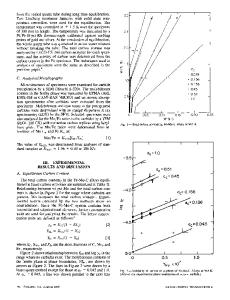Thermodynamics of the iron-carbon-zinc system
- PDF / 904,395 Bytes
- 10 Pages / 603.28 x 783.28 pts Page_size
- 85 Downloads / 371 Views
I.
INTRODUCTION
O N E of the more significant developments in the market for steel products over the past decade has been the steady increase in the use of galvanized products. Current United States shipments of galvanized sheet and strip are almost twice their 1980 level. Il~ As might be expected, this increase in galvanized steel usage has coincided with an increase in the amount of galvanized material in scrap supplies, now almost 30 pet of the typical No. 1 bundle. The increased galvanized steel content of steel scrap in turn means an increasing amount of zinc in the charge to both primary and secondary steelmaking vessels. [~,21 Most of the zinc charged to steelmaking furnaces eventually volatilizes from the molten steel, oxidizing in the atmosphere above the melt to form the zinc oxide component of basic oxygen furnace (BOF) and electric arc furnace (EAF) dusts; but the actual volatilization process is not so simple. Zinc contained in densely compacted scrap bales at the bottom of a charge may often stay in solution during the melting process, held there by the ferrostatic pressure of the molten metal above it. ~ When the pressure is released during tapping or by stirring in a ladle, a second zinc fume is generated, presenting an additional work-environment challenge.t3.4.51 Further zinc volatilization may occur during solidification, according to various anecdotal evidence, m The small amount of zinc that remains in the metal as it solidifies can be a source of concern as well. Wolf has pointed out that zinc diffusion into copper continuouscasting molds is a cause of mold-face cracking, t61 and the grain-boundary embrittlement of solidifying iron caused by segregating zinc is equally well known.t71 Dissolved zinc affects the properties of higher-carbon alloys as well. At contents above 1000 parts per million (ppm), it retards nodularization of graphite in ductile irons;t4~ in other irons, it slows the austenite-pearlite transformation, promoting the retention of proeutectoid ferrite and WENZHONG LUO, Technical Service Engineer, is with Allied Mineral Products, Columbus, OH. MARK E. SCHLESINGER, Assistant Professor, is with the Department of Metallurgical Engineering, University of Missouri-Rolla, Rolla, MO 65401-0249. Manuscript submitted September 20, 1993. METALLURGICAL AND MATERIALS TRANSACTIONS B
bainite, tS's'91 As a result, the ability to predict the disposition of zinc charged to steelmaking processes is increasingly significant in assuring product quality. Molten iron-carbon alloys have recently been used experimentally as a medium for the carbothermic production of zinc vapor by reduction of the oxide, I1~ and knowing the thermodynamic properties of these melts would also be advantageous in optimizing this process. Most of the existing database on the thermodynamic characteristics of the iron-zinc system has been obtained with an emphasis on equilibria related to the galvanizing process and is of limited value in modeling zinc behavior during molten steel processing. Measurements of the activity
Data Loading...











